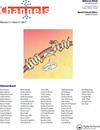Hysteresis in voltage-gated channels
IF 3.2
3区 生物学
Q2 BIOCHEMISTRY & MOLECULAR BIOLOGY
引用次数: 34
Abstract
ABSTRACT Ion channels constitute a superfamily of membrane proteins found in all living creatures. Their activity allows fast translocation of ions across the plasma membrane down the ion's transmembrane electrochemical gradient, resulting in a difference in electrical potential across the plasma membrane, known as the membrane potential. A group within this superfamily, namely voltage-gated channels, displays activity that is sensitive to the membrane potential. The activity of voltage-gated channels is controlled by the membrane potential, while the membrane potential is changed by these channels' activity. This interplay produces variations in the membrane potential that have evolved into electrical signals in many organisms. These signals are essential for numerous biological processes, including neuronal activity, insulin release, muscle contraction, fertilization and many others. In recent years, the activity of the voltage-gated channels has been observed not to follow a simple relationship with the membrane potential. Instead, it has been shown that the activity of voltage-gated channel displays hysteresis. In fact, a growing number of evidence have demonstrated that the voltage dependence of channel activity is dynamically modulated by activity itself. In spite of the great impact that this property can have on electrical signaling, hysteresis in voltage-gated channels is often overlooked. Addressing this issue, this review provides examples of voltage-gated ion channels displaying hysteretic behavior. Further, this review will discuss how Dynamic Voltage Dependence in voltage-gated channels can have a physiological role in electrical signaling. Furthermore, this review will elaborate on the current thoughts on the mechanism underlying hysteresis in voltage-gated channels.电压门控通道中的迟滞
离子通道构成了一个存在于所有生物体内的膜蛋白超家族。它们的活性允许离子沿着离子的跨膜电化学梯度在质膜上快速易位,从而导致质膜上的电势差异,称为膜电位。这个超家族中的一组,即电压门控通道,显示出对膜电位敏感的活性。电压门控通道的活性受膜电位控制,而膜电位又受这些通道活性的影响。这种相互作用产生了膜电位的变化,在许多生物体中演变成电信号。这些信号对许多生物过程至关重要,包括神经元活动、胰岛素释放、肌肉收缩、受精等。近年来,观察到电压门控通道的活性与膜电位的关系并不简单。相反,已经证明电压门控通道的活动表现出滞后。事实上,越来越多的证据表明,通道活性的电压依赖性是由活性本身动态调节的。尽管这种特性对电信号有很大的影响,但电压门控通道中的迟滞往往被忽视。针对这个问题,本综述提供了电压门控离子通道显示滞后行为的例子。此外,本文将讨论电压门控通道中的动态电压依赖性如何在电信号中发挥生理作用。此外,本文将详细阐述目前对电压门控通道中迟滞机制的看法。
本文章由计算机程序翻译,如有差异,请以英文原文为准。
求助全文
约1分钟内获得全文
求助全文
来源期刊

Channels
生物-生化与分子生物学
CiteScore
5.90
自引率
0.00%
发文量
21
审稿时长
6-12 weeks
期刊介绍:
Channels is an open access journal for all aspects of ion channel research. The journal publishes high quality papers that shed new light on ion channel and ion transporter/exchanger function, structure, biophysics, pharmacology, and regulation in health and disease.
Channels welcomes interdisciplinary approaches that address ion channel physiology in areas such as neuroscience, cardiovascular sciences, cancer research, endocrinology, and gastroenterology. Our aim is to foster communication among the ion channel and transporter communities and facilitate the advancement of the field.
 求助内容:
求助内容: 应助结果提醒方式:
应助结果提醒方式:


